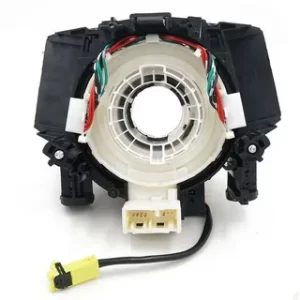Your 2006 Nissan Murano is a reliable companion on the road, but like any vehicle, it has its quirks. One critical component that often gets overlooked is the clock spring. This small yet vital part connects your steering wheel controls to the vehicle’s electrical system, allowing you to seamlessly use features like airbag deployment and cruise control. Understanding when your Clock Spring Nissan Murano 2007 needs replacement can save you from potential headaches.
Importance of the Clock Spring
The clock spring is a crucial component in your 2006 Nissan Murano. It connects the steering wheel to the vehicle’s electrical systems, allowing communication between various components. This includes airbag deployment and controls for audio or cruise settings.
When you turn the steering wheel, the clock spring maintains that connection without interruption. If it fails, you could lose access to essential functions while driving, making your journey less convenient and potentially unsafe.
Moreover, a malfunctioning clock spring may trigger warning lights on your dashboard. Ignoring these signs can lead to further complications. Addressing issues promptly helps maintain vehicle safety and functionality.
Understanding its importance allows drivers to recognise when something goes wrong early on. Regular check-ups help catch potential problems before they escalate into more significant issues requiring costly repairs.
Common Symptoms of a Faulty Clock Spring
A faulty clock spring can cause several noticeable issues in your 2006 Nissan Murano. One of the first signs is an unresponsive airbag warning light on your dashboard. This light is a crucial indicator that something isn’t right, potentially affecting passenger safety.
Another common symptom includes irregularities with steering wheel controls. If you notice that audio or cruise control buttons are not functioning correctly, it may point to clock spring problems. These controls rely on a properly functioning connection within the steering column.
You might also experience abnormal horn behaviour, such as intermittent honking or complete failure. This issue arises because the clock spring maintains electrical connections for these functionalities.
If your vehicle’s traction control system becomes erratic or engages unexpectedly, this could signal a malfunctioning clock spring; paying attention to these symptoms can help you catch potential issues early and ensure safer driving experiences.
Diagnostic Trouble Codes (DTCs)
Diagnostic Trouble Codes (DTCs) are critical for understanding your 2006 Nissan Murano issues. These codes act as a communication tool between your vehicle and the diagnostic scanner. The onboard computer generates a DTC that pinpoints specific malfunctions when something goes wrong.
For instance, if the clock spring is faulty, you might see codes like B2100 or B2638. Each code corresponds to different problems within the airbag system or steering wheel controls. Accessing these codes can help you identify whether you need a clock spring replacement.
Using an OBD-II scanner makes retrieving DTCs simple. You plug it into the diagnostic port under your dashboard and follow the prompts on its screen. This quick process saves time when diagnosing issues.
Remember that while DTCs provide valuable insights, they may need to tell the complete story about your vehicle’s condition. Additional inspections are often necessary to confirm any findings before taking action.
Impact on Vehicle Performance
A faulty clock spring in your 2006 Nissan Murano can significantly impact vehicle performance. This essential component connects the steering wheel controls to the vehicle’s electrical systems. When it malfunctions, you might experience erratic behaviour from various functions.
One immediate effect is the loss of functionality for features like cruise control and airbag deployment. If these critical safety elements fail, you could be at risk on the road.
You may also notice issues with steering wheel-mounted buttons not responding correctly, affecting everything from volume control to navigation settings. It can be frustrating when you’re trying to focus on driving.
Moreover, a damaged clock spring can cause warning lights to illuminate your dashboard. Ignoring these signals may result in more significant problems, impacting safety and comfort during your drives.
Visual Inspection Tips of 2006 Nissan Murano Clock Spring Replacement
When checking your 2006 Nissan Murano Clock Spring Replacement issues, start with a visual inspection of the steering column area. Look for any signs of wear or damage around the steering wheel. Cracks or frayed wires can indicate potential problems.
Next, examine the airbag indicator light on your dashboard. If it’s illuminated and you’ve recently had an accident or bump in that area, it could be linked to the clock spring malfunctioning.
Additionally, inspect any related components, such as the horn and cruise control buttons. If they’re not functioning correctly, this may suggest a deeper issue with the clock spring itself.
Check for loose connections in wiring harnesses near the steering wheel. A secure connection is vital for proper operation; if something seems off here, consider further investigation into your clock spring’s health.
Professional Diagnosis vs. DIY
When diagnosing a faulty clock spring in your 2006 Nissan Murano, you have two options: professional diagnosis or tackling the issue yourself. Each approach has its own merits and challenges.
A professional mechanic brings experience and specialized tools to assess the problem accurately. Their expertise can save you time and potentially costly mistakes. Additionally, they often provide warranties for their work, giving you peace of mind.
On the other hand, if you’re handy with car repairs, a DIY approach may appeal to you. It allows for personal involvement in maintaining your vehicle while saving some money on labour costs. However, without proper knowledge or tools, misdiagnosing an issue could lead to further complications.
Before deciding between these two paths, consider your comfort level with automotive repairs and whether you have access to reliable resources.
Step-by-Step Replacement Guide to 2007 Nissan Murano Clock Spring
Replacing the 2007 Nissan Murano Clock Spring can seem daunting, but with some careful steps, you can tackle it. Start by disconnecting the battery to prevent any electrical mishaps during the process. This is a crucial safety measure.
Next, carefully remove the airbag module from the steering wheel. Follow your vehicle’s service manual for specifics on unfastening it without causing damage. Once that’s done, gently pull off the steering wheel using a puller tool if necessary.
After removing the wheel, locate and unscrew the old clock spring assembly. Note its orientation, as proper alignment is vital for functionality later on. Install your new clock spring in reverse order, ensuring all connectors are secure.
Reassemble everything with care and reconnect your battery. It’s wise to check everything before hitting the road again!
Testing and Calibration After Replacement
After replacing the clock spring in your 2006 Nissan Murano, thorough testing and calibration are essential to ensure all steering wheel-related functions work correctly, ensuring safety and reliability.
Reconnect the Battery and Check for Warning Lights
Start by reconnecting your vehicle’s battery and checking for any warning lights on the dashboard. This initial step is crucial to ensure the system is powering up correctly.
Test Controls During a Short Drive
Take a short drive, paying attention to the responsiveness of controls like airbag deployment, horn functionality, and cruise control settings. Any unresponsive or off-feeling controls may require further inspection.
Calibration with Diagnostic Equipment
Calibration often involves using specialized diagnostic equipment. If you’re not comfortable doing it yourself, seek professional help. Proper calibration ensures that features work seamlessly together without future issues.
Maintenance Tips for Longevity your 2007 Nissan Murano Clock Spring Replacement
Regular maintenance is key to ensuring the longevity of your 2007 Nissan Murano Clock Spring Replacement Start by keeping the steering wheel free of excessive force and avoiding sudden jerks while driving. Gentle handling can significantly reduce wear on sensitive components like the clock spring.
Routine inspections are also beneficial. Schedule periodic checks to look for signs of damage or wear around the steering column area. Early detection can save you from more serious issues down the line.
Additionally, keep an eye on your dashboard warning lights. If any indicators related to airbag systems or electrical malfunctions appear, address them immediately—delays could lead to more significant problems.
Using quality replacement parts during repairs enhances durability and performance. Opt for OEM (original equipment manufacturer) parts when possible; they’re designed specifically for your vehicle’s needs and will help maintain optimal function over time.
Conclusion
Ensuring your Clock Spring Nissan Murano 2007 operates smoothly involves understanding its components, like the clock spring. This delicate part plays a crucial role in vehicle safety and functionality. Recognizing the signs early can save you time and money when issues arise. Taking action upon noticing symptoms is essential. If you’re experiencing problems with airbags or steering controls, diagnosing the situation promptly is vital. Ignoring these indicators could lead to more severe complications down the line.
FAQs
What is a Clock Spring Nissan Murano 2007?
A Clock Spring Nissan Murano 2007 is an electrical component that maintains the connection between various control systems in your vehicle’s steering wheel and other functions while allowing for movement.
How do I know if my clock spring needs replacing?
Look for symptoms such as airbag warning lights, malfunctioning horn or cruise control, and abnormal noises when turning the steering wheel.
Can I drive my Murano with a faulty clock spring?
It’s not advisable to drive with a faulty clock spring. It can affect critical safety features like airbags and lead to further complications.
What does the replacement process involve?
Replacing a clock spring typically involves disconnecting the battery, removing airbag components, and carefully swapping out the old unit for a new one.



